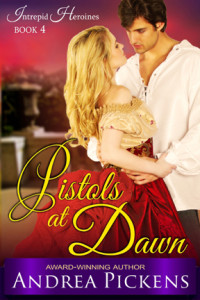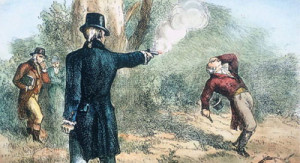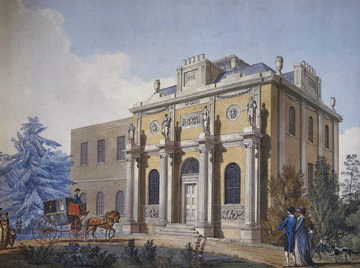 It’s Tuesday, and Amanda has a deadline coming up in–gasp!–two weeks! In desperation, she turned to her friend Andrea Pickens aka Cara Elliott (who has some very exciting re-issues out) to fill in….
It’s Tuesday, and Amanda has a deadline coming up in–gasp!–two weeks! In desperation, she turned to her friend Andrea Pickens aka Cara Elliott (who has some very exciting re-issues out) to fill in….
Hi Everyone,
Andrea Pickens here, (that is, Cara Elliott slipping back into her OTHER Regency gown. It’s been hanging in the armoire for a while, but my lady’s maid has freshened up the lace and flounces, so I am ready to take a new twirl on the ballroom floor.) Amanda’s dueling with a looming deadline, so I volunteered to take a shot at today’s post . ..
 I confess that my aim is not entirely altruistic. Pistols At Dawn, my new, never-before-published traditional Regency is making its debut as an e-book on all the major platforms on June 2, so of course, I’d love to trigger your interest. (Okay, okay, enough with the gun references, but a pistol does figure prominently in the opening scene.)
I confess that my aim is not entirely altruistic. Pistols At Dawn, my new, never-before-published traditional Regency is making its debut as an e-book on all the major platforms on June 2, so of course, I’d love to trigger your interest. (Okay, okay, enough with the gun references, but a pistol does figure prominently in the opening scene.)
A metallic click caused Marcus Fitzherbert Greeley, the seventh Earl of Killingworth to look up from his ledgers.
“Who’s there?” he called sharply.
No answer sounded in reply, but after a moment the draperies stirred and a dark shape emerged from the midnight shadows. As the cloaked figure approached his desk, candlelight glinted off the steel of an ancient pistol.
“Stand up,” came the curt command.
The case clock ticked off a second or two before the earl put down his pen and rose.
“Take off your coat.”
He didn’t move, save for a slight twitch of his raven brows.
“You think a mere female incapable of pulling the trigger? I assure you, I should like nothing better, if you give me the slightest provocation.” The young lady—for her speech, if not her actions, indicated that she was indeed a lady—stepped closer. “And in case you are wondering, I am accorded to be a decent shot.”
I started my writing career Signet, which, as most of you know, published a special line of traditional Regency romances. I did ten books for them, during which time I learned an amazing amount of stuff, both about the craft of writing and the intricate nuances of the era. (And also met some of my best friends to this day, including Amanda!)
Like many Signet authors, I got the rights back to those early books and the process of getting them re-edited and formatted for self-publishing, made me think a lot about the “trad” Regency form and what I loved about it. For one, it’s a shorter length, usually 60-70,000 words rather than the 85-95,000 of mass market historical, and with fewer words to play with, an author has to really concentrate on developing the character arc—what’s the core conflict that is keeping the hero and heroine apart, and how do they grow and change in order to resolve it? Plot is of course important, but at heart, it’s the main characters who must stay in clear focus.
But what I also loved about the “rules” of the trad was that you really had to know your facts about the Regency. Want to write about pistols? Well, you had better research the details, and get them right, as core readers expected a high level of expertise. Since I love arcane facts about history, that part of writing was always great fun. So, when I found an old, unfinished manuscript for a trad Regency in my desk drawer, I decided to go back to my roots and finish it.
Things have gotten looser these days in Regency historical. Many authors don’t feel compelled to be quite as “authentic” as in the trads. The stories are still wonderful, they are just . . . different. In sitting down to finish Pistols At Dawn, I really enjoyed the fact that I had to rein in certain urges, and work within tighter constraints. I found myself dusting off old research books to do some background reading. Take, for examples, pistols. Now, most of us have heard of Joseph Manton but did you known the most famous gunmaker of the late Georgian/early Regency era was Robert Wogdon? (He made the weapons used in the infamous Aaron Burr-Alexander Hamilton duel, and one of the innovations that he helped pioneer was the hair—or “set”—trigger.) Indeed, in England his name became so synonymous with dueling that dawn encounter was sometimes referred to as a “Wogdon affair.”
 Now pistols actually play a very small role in my new book, but no matter—the enjoyment of reading and researching about the subject was well worth the hours spent. (Another fun fact—smoothbore weapons were considered more sporting for dueling . . . but even Manton was said to have “cheated” a little by adding rifling deep within the barrel for greater accuracy, but leaving the last few inches smooth, so it looked like an unrifled pistol.)
Now pistols actually play a very small role in my new book, but no matter—the enjoyment of reading and researching about the subject was well worth the hours spent. (Another fun fact—smoothbore weapons were considered more sporting for dueling . . . but even Manton was said to have “cheated” a little by adding rifling deep within the barrel for greater accuracy, but leaving the last few inches smooth, so it looked like an unrifled pistol.)
I could, of course go on and on about all the other esoteric discoveries I’ve made concerning the world of the Regency, but I’d rather wrap up my visit here by firing a question at you—What’s one of the most fun or interesting facts you’ve learned while reading the Regency? It can be about fashion, music, art, people, everyday objects—anything! Please share. (I’ll be giving away an e-book edition of Pistols At Dawn to one person chosen at random from among those who leave a comment here between now and Thursday.)


Andrea! (or Cara) How delightful to have you back and to hear you have a never before issued Traditional Regency to offer us!!!
I loved the Trads as a reader. Loved the short length and the attention to historical detail and accuracy. I’m still sorta stuck in the accuracy camp.
I’m already hooked just with the short excerpt you gave us!
Thanks, Diane! I really do love the tighter form and the trope of staying true to the historical details of the period, too!
The keeping to details and the clothing seemed very proper at all time’s
Signets were the first romances I read decades ago and I still love them. In fact I just finished reading a other of Andrea’s books, The Banished Bride. I’ve learned a lot about 19th Century medical practices by reading Regencies, particularly the horrifying habit of bleeding.
I love what was considered “scandal” during Regency times.
21st Century scandals are all about the sex tapes. But during the Regency, a scandal could be financial, or about honour (one’s character has been besmirched), or even which tailor one patronised. Bluestockings! Lower-class riots!
I find it refreshing and quite a change from whatever Kimye’s been up to.
I love a good scandal and try to include one in each of my Regencies.
the fashion
That people believed in ideals, whether or not they actually measured up.
https://t.me/s/official_Kometa_ed